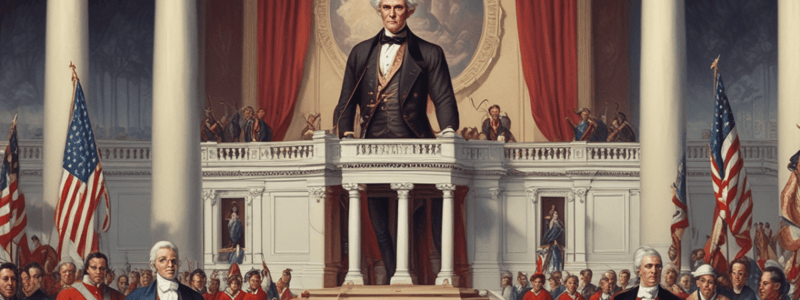Podcast
Questions and Answers
What was one of Andrew Jackson's main ambitions as president?
What was one of Andrew Jackson's main ambitions as president?
- To maintain the existing borders of the United States
- To focus on domestic policy rather than expansion
- To improve relations with Native American tribes
- To expand the United States westward across the continent (correct)
What policy did Jackson sign into law in 1830 that allowed him to exchange lands with Native American tribes?
What policy did Jackson sign into law in 1830 that allowed him to exchange lands with Native American tribes?
- The Westward Expansion Act
- The Indian Removal Act (correct)
- The Native Land Exchange Treaty
- The Manifest Destiny Proclamation
What event became known as the 'Trail of Tears' as a result of the Indian Removal Act?
What event became known as the 'Trail of Tears' as a result of the Indian Removal Act?
- The forced removal of the Cherokee nation westward (correct)
- The relocation of Native American tribes to reservations
- The expansion of the United States across the continent
- The violent conflicts between settlers and Native Americans
What were some of Andrew Jackson's views toward Native Americans?
What were some of Andrew Jackson's views toward Native Americans?
What was Andrew Jackson's background prior to becoming president?
What was Andrew Jackson's background prior to becoming president?
What was one of the main arguments used to justify the Indian Removal Act?
What was one of the main arguments used to justify the Indian Removal Act?
What was the main argument used by the Cherokee Nation in the Supreme Court case Cherokee Nation v. Georgia?
What was the main argument used by the Cherokee Nation in the Supreme Court case Cherokee Nation v. Georgia?
What was the main reason most Cherokees opposed the Treaty of New Echota?
What was the main reason most Cherokees opposed the Treaty of New Echota?
Which Native American resistance movement is NOT mentioned in the text?
Which Native American resistance movement is NOT mentioned in the text?
What was the main reason the Supreme Court ruled in favor of the Cherokee in the Worcester v. Georgia case?
What was the main reason the Supreme Court ruled in favor of the Cherokee in the Worcester v. Georgia case?
Which of the following statements accurately describes the role of Native American tribes during the conflict mentioned in the text?
Which of the following statements accurately describes the role of Native American tribes during the conflict mentioned in the text?
What was the primary motivation behind Andrew Jackson's policy of Indian removal?
What was the primary motivation behind Andrew Jackson's policy of Indian removal?
What was the primary factor that served as an impetus for advocates of removal to push the Cherokee from their lands in the 1830s?
What was the primary factor that served as an impetus for advocates of removal to push the Cherokee from their lands in the 1830s?
Which of the following groups opposed the Indian Removal Act of 1830?
Which of the following groups opposed the Indian Removal Act of 1830?
What was a key factor that shaped Andrew Jackson's policies and views towards Native Americans?
What was a key factor that shaped Andrew Jackson's policies and views towards Native Americans?
What was the primary goal of the Indian Removal Act signed by Andrew Jackson in 1830?
What was the primary goal of the Indian Removal Act signed by Andrew Jackson in 1830?
What event became known as the "Trail of Tears" during the implementation of the Indian Removal Act?
What event became known as the "Trail of Tears" during the implementation of the Indian Removal Act?
Which of the following statements best describes the concept of "Manifest Destiny" during Andrew Jackson's presidency?
Which of the following statements best describes the concept of "Manifest Destiny" during Andrew Jackson's presidency?
What was Andrew Jackson's background before becoming president?
What was Andrew Jackson's background before becoming president?
What was the Cherokee Nation's argument in the Supreme Court case Cherokee Nation v. Georgia?
What was the Cherokee Nation's argument in the Supreme Court case Cherokee Nation v. Georgia?
Why did the Cherokee Nation not win the Cherokee Nation v. Georgia case initially?
Why did the Cherokee Nation not win the Cherokee Nation v. Georgia case initially?
How did President Jackson react to the Supreme Court's ruling in Worcester v. Georgia?
How did President Jackson react to the Supreme Court's ruling in Worcester v. Georgia?
Why did most Cherokees oppose the Treaty of New Echota?
Why did most Cherokees oppose the Treaty of New Echota?
What was a key reason why General Winfield Scott and troops were sent to force the Cherokee to leave their lands?
What was a key reason why General Winfield Scott and troops were sent to force the Cherokee to leave their lands?
Which of the following was a primary goal of the Indian Removal policy?
Which of the following was a primary goal of the Indian Removal policy?
What was the primary reason the Whigs and Abolitionists opposed the Indian Removal Act of 1830?
What was the primary reason the Whigs and Abolitionists opposed the Indian Removal Act of 1830?
Which of the following statements accurately describes the 'Five Civilized Tribes' mentioned in the text?
Which of the following statements accurately describes the 'Five Civilized Tribes' mentioned in the text?
What was the primary factor that served as an impetus for advocates of removal to push the Cherokee from their lands in the 1830s?
What was the primary factor that served as an impetus for advocates of removal to push the Cherokee from their lands in the 1830s?
Which of the following statements best describes the Cherokee's response to the Indian Removal policy?
Which of the following statements best describes the Cherokee's response to the Indian Removal policy?
Flashcards are hidden until you start studying
Study Notes
The Indian Removal Act and Trail of Tears
- The Indian Removal Act was signed into law by President Andrew Jackson in 1830, allowing the president to exchange lands west of the Mississippi River for those on which Native Americans currently resided.
- The act was supported by whites in the Southeast who were eager to take land and expand west, but was opposed by groups such as the Whigs and the Abolitionists.
Andrew Jackson and Native Americans
- Andrew Jackson, the seventh president of the United States, held disparaging and racist views toward Native Americans, referring to them as "savages."
- Jackson was a slaveholder and believed in the idea of Manifest Destiny, the expansion of the United States westward across the continent.
- As president, Jackson actively pursued a policy of Indian removal, which meant pushing Native American tribes west in order to separate them from white settlers.
Cherokee Nation and the Trail of Tears
- The Cherokee Nation, one of the "Five Civilized Tribes," originally occupied land in present-day Georgia, North Carolina, Tennessee, and Alabama.
- The Cherokee had adopted aspects of European culture, such as developing a writing system and introducing individual ownership of land.
- The discovery of gold on Cherokee lands in 1828 served as an impetus for advocates of removal to push them from their lands.
- The Treaty of New Echota was signed in 1835, offering five million dollars in exchange for the Cherokee's lands, but most Cherokees opposed the treaty and wished to remain where they were.
- By 1838, only 2,000 (of 16,000 total) Cherokee had voluntarily moved west.
- In the spring of 1838, the federal government sent General Winfield Scott and 7,000 troops to force the Cherokee to leave their lands, resulting in the Trail of Tears, a brutal journey that killed thousands.
Resistance and Court Cases
- There were movements of resistance to the Indian Removal Act, such as the Second Seminole War (1835-1842) and the Third Seminole War (1855-1858) in Florida.
- The Cherokee Nation turned to the Supreme Court to protect themselves from laws being passed at the state and federal level to force them from their land.
- In Cherokee Nation v. Georgia (1831), the Cherokee Nation argued that laws forcing them from their land were unconstitutional and violated treaties between the Cherokee and the US government.
- On March 3, 1832, the Supreme Court reversed their decision and ruled that states did not have the power to regulate Native American land, but Jackson ignored the Court's ruling and proceeded to enforce the policy of Indian removal.
Studying That Suits You
Use AI to generate personalized quizzes and flashcards to suit your learning preferences.





